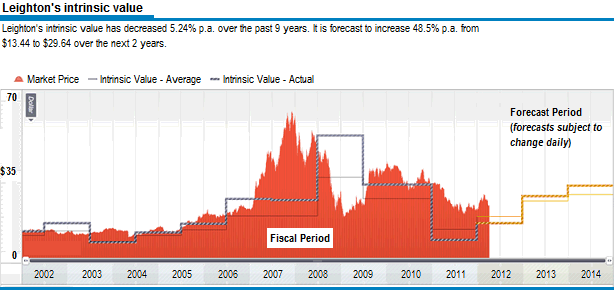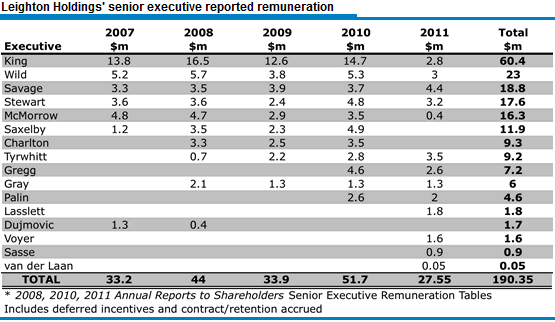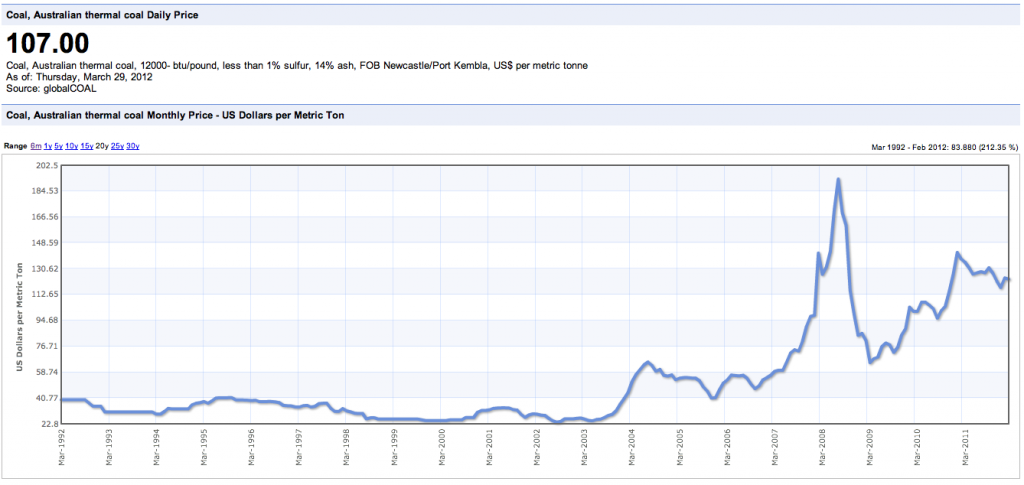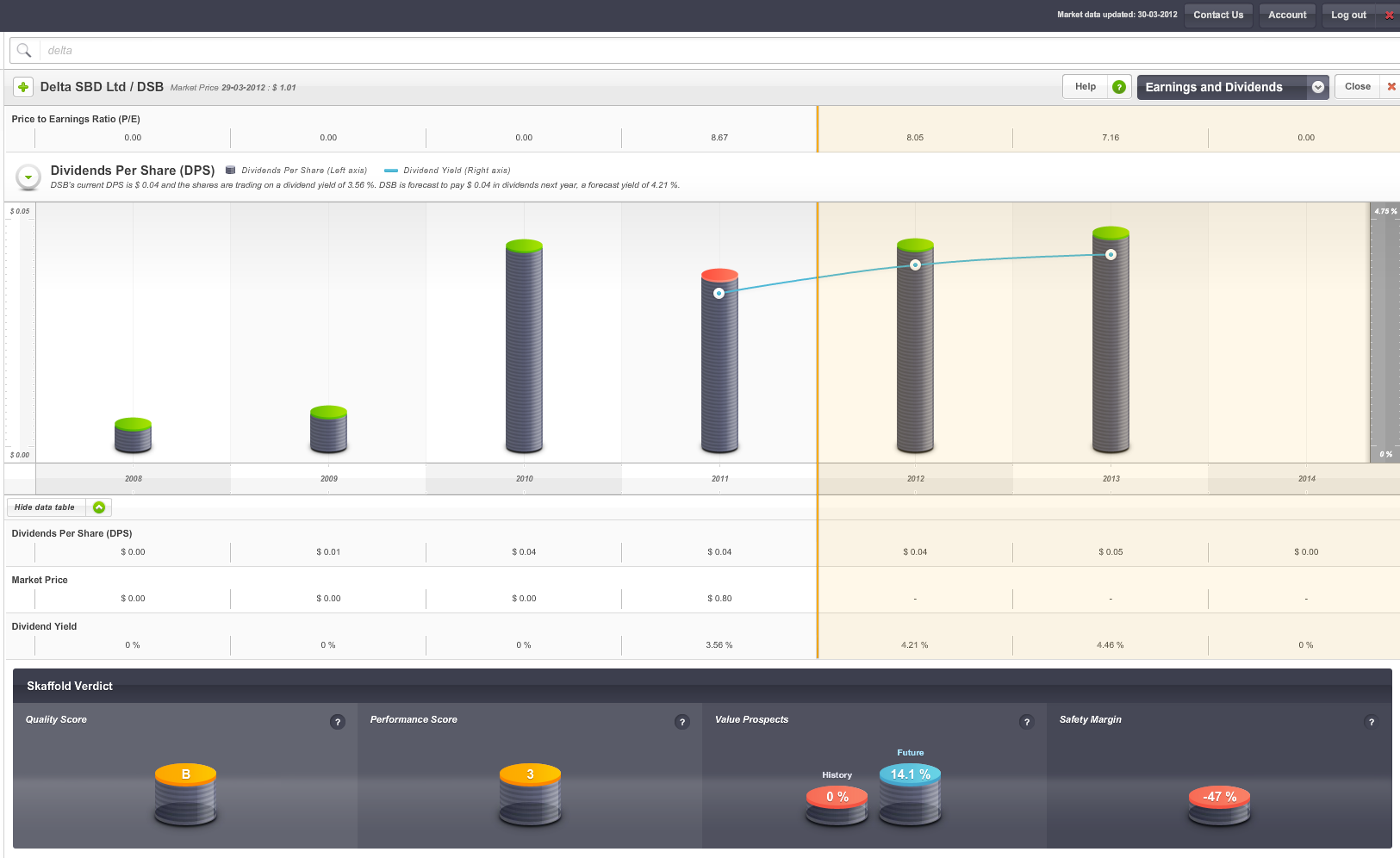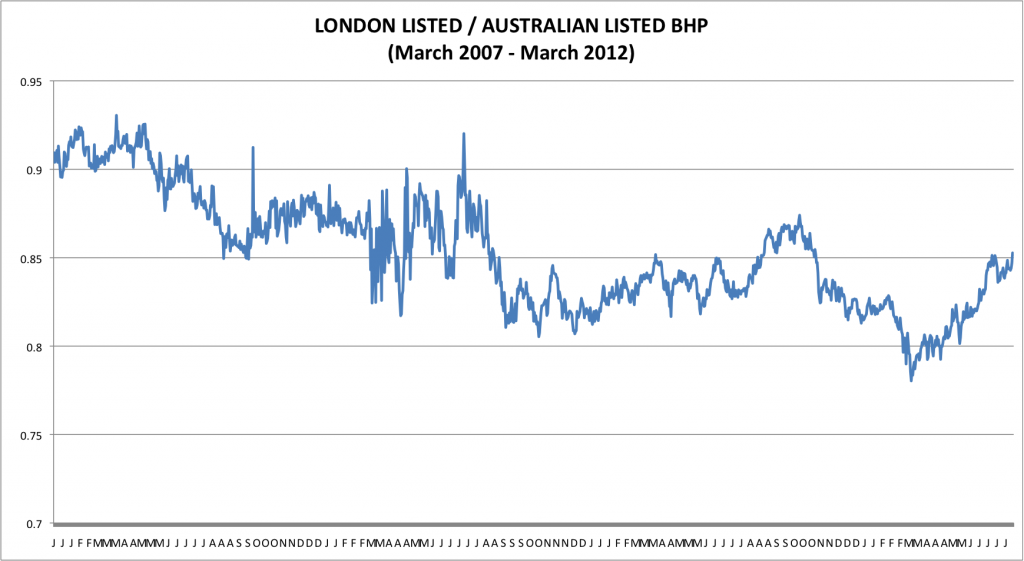Energy / Resources
-

MEDIA
Is BHP an under performing stock?
Roger Montgomery
May 2, 2012
Roger Montgomery uses Value.able investing techniques to assess the management choices made by BHP executives over the last 20 years with Ross Greenwood and stockbroker Michael Whiting. Listen.
by Roger Montgomery Posted in Energy / Resources, Radio.
- save this article
- POSTED IN Energy / Resources, Radio
-

MEDIA
Given the outlook for Chinese growth and iron-ore prices, is it time to cast a critical eye over your BHP holdings?
Roger Montgomery
April 20, 2012
Roger Montgomery discusses how and if you should respond to the impact of changing global conditions on your BHP [BHP] stock holding. Read here.
by Roger Montgomery Posted in Energy / Resources, On the Internet, Skaffold.
- save this article
- POSTED IN Energy / Resources, On the Internet, Skaffold
-
They may never be needed but are there enough?
Roger Montgomery
April 18, 2012
 Republished: PORTFOLIO POINT: Leighton’s recent performance issues have been exacerbated by a poor relationship between management and staff.
Republished: PORTFOLIO POINT: Leighton’s recent performance issues have been exacerbated by a poor relationship between management and staff.The 15th of April will mark the 100-year anniversary of the tragic sinking of the Titanic on its maiden voyage from Southampton England to New York. Owned by The Oceanic Steam Navigation Company or White Star Line of Boston Packets, the tragedy was not that her advanced safety features, which included watertight compartments and remotely activated watertight doors malfunctioned. The tragedy was the operational failure and that the Titanic lacked enough lifeboats to accommodate any more than a third of her total passenger and crew capacity.
It occurred to me on this anniversary that there are many lumbering, giant business boats listed on the Australian stock exchange today, whose journeys have been equally eventful, if not fatal, and whose management is no less responsible for operational failures and for providing lifeboats only for themselves.
Take the situation over at Leighton (ASX: LEI) – a company I wrote about here some time ago, saying: “There is a significant risk of downward revisions to current forecasts for the 2012 profit.” On March 30, the company wrote a further $254 million off its two biggest projects – Airport Link and the Victorian desalination plant. More broadly, Leighton downgraded its FY12 profit guidance to $400 million-$450 million from $600 million-$650 million, taking the company’s writedown tally to almost $2 billion in the past two years. This will reduce the return on equity from 22% to 15% for 2012, and significantly reduce the 2012 intrinsic value, which now sits below $14.00 (see graph below).
Source: Skaffold.com
Back when I wrote my prediction, I also noted that workers at the desalination plant had cited ‘safety concerns’ causing them to work more cautiously (read slowly) to ensure their physical safety and the safety of their $200,000 per year wage, which of course would not continue beyond the project’s completion.
This week, it was revealed that similar problems have emerged at Brisbane’s Airport Link project. According to one report, “an increasing level of aggressive behaviour” from unionised workers who wanted to “get paid for longer” was an attempt to “leverage this finishing phase” of the project.
Leighton must construct to a deadline, and liquidated damages clauses cost the company about $1.1 million per day for every day that the Airport Link project is delayed. My guess is that as a result of the workforce’s alleged ‘go slow’, Leighton is forced to bring in hundreds of sub-contractors such as sparkies (with “specialist commissioning skills and experience”, according to John Holland) to complete the work. Either way, it costs Leighton more. A 25% blow-out on a multi-billion dollar project can amount to $1 billion.
On top of these problems, Leighton has a $200 million deferred equity commitment to make two years after Airport Link opens. And if my speculation that the operator may be broke before Christmas comes to fruition, Leighton will be forced to write off another $63 million – the amount remaining to be written down.
But before you jump to attack the unions reported to be responsible for Leighton’s woes – something I believe is often justified, not because of what the unions represent, which is honourable, but because of the tactics they sometimes use to seek redress – you should remember that there are many companies whose more humble management works in harmony with its workforces, unionised or otherwise.
Management is an important part of the investment analysis mix and while I firmly believe, as Buffett does, that the business boat you get into is far more important than the man doing the rowing, I do also believe that management will make the bed that ultimately every stakeholder must lie in.
Any company whose management drives flash cars to the office, pays herculean salaries to themselves and/or takes advantage of company relationships for self-gain is always going to be the target of unrest and distrust from its staff. This is driven often by envy, a sense of unfairness or lack of equity, and while I am not saying this is the case at Leighton, clearly there’s something amiss that is the root cause of this much trouble.
Over the last decade, Leighton has generated cash flow from operations of $8.3 billion, but its capital expenditure has now exceeded $7.5 billion. This would leave $800 million for dividends, but the company has paid dividends of over $2 billion (perhaps to appease non-unionised, income-seeking shareholders who support the share price upon which management’s lucrative remuneration is based). Given the cash to fund this dividend largesse was not generated by business operations, $850 million of ownership-diluting equity has been raised and $1.3 billion of debt borrowed. And for this less-than-spectacular performance, the top 10 current executives were paid almost $20 million last year. Eight of those were paid more than $1.2 million in 2011, four were paid more than $2.3 million, and the year before, three of the 10 were paid more than $4.5 million each.
Forecast profits for 2012 will not be any higher than five years ago, and the company workforce has doubled to 51,281 employees at June 30, 2011. But $190 million in salaries for 15 senior executives (excluding van der Laan’s $47,000) between 2007 and 2011 (see table), while overseeing such performance does not sit well with staff (or vocal but ineffectual minority shareholders) and it’s the relationship between management and staff that is more than partly to blame for the company’s ills.
Whether or not the CFMEU’s Dave Noonan’s claim in The Australian Financial Review this week is correct – specifically that “the markets were the last to know [about Airport Link], everybody else in the industry knew that the company were going to drop hundreds of millions of dollars and obviously they chose to tell the stock market very late in the piece” – is less significant than whether a carcinogenic tumour has grown between management and staff. The former can be resolved but the latter is potentially more permanent, and therefore damaging to shareholder returns.
Leighton is a fixture in the portfolios of thousands of superannuants nearing retirement and their disappointment with their investment returns can be at least partly attributed to the poor wealth-creating contribution of this company and its management. In turn, this can be attributed to the motivation and satisfaction of staff.
Shareholders are also the owners and have a right to know how management is performing, but now the majority shareholder’s demands will hold sway and the majority shareholder is Spain’s Grupo ACS, not the many Australian super funds who thought the company’s management was working for them. Oh, and I am guessing there is the risk of further writedowns on projects that haven’t yet hit the headlines.
Like the Titanic, where only the executives at White Star Line were truly safe, minority shareholders may find there aren’t enough lifeboats for them either.
First Published at Eureka Report April 11. Republished and Posted by Roger Montgomery, Value.able author, Skaffold Chairman and Fund Manager, 19 April 2012.
by Roger Montgomery Posted in Companies, Energy / Resources, Insightful Insights, Investing Education, Manufacturing, Skaffold.
-
Building Heaps & Piles at BHP
Roger Montgomery
April 18, 2012
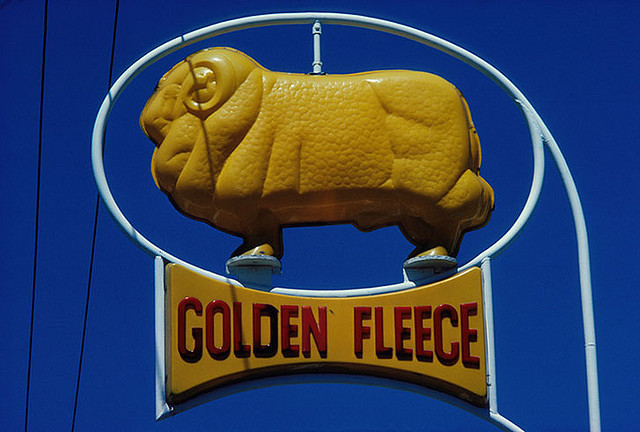 PORTFOLIO POINT: Given the outlook for Chinese growth and iron ore prices, is it time to cast a critical eye over your BHP holding?
PORTFOLIO POINT: Given the outlook for Chinese growth and iron ore prices, is it time to cast a critical eye over your BHP holding?The 2001 merger of BHP Limited and Billiton Plc created the world’s largest diversified resource company. The company is also one of the largest in the world by market capitalisation and I would guess one of the longest-held stocks in many investors’ portfolios, as well as one of the most likely to have been inherited by superannuants from their parents.
Operationally, the company is nothing like it once was. Seriously underperforming assets and overpriced acquisitions had to be written off in the late 1990s, and since then external candidates including Paul Anderson, Brian Gilbertson, Chip Goodyear and, most recently, Marius Kloppers have taken the top job at the Big Australian. Under their sound stewardship – and the biggest mining boom in history – BHP’s share price has risen from less than $10 when the merger was consummated to almost $50 prior to the GFC, and again a year ago. But since then, BHP’s share price has crashed 30%.
A year ago, with the share price at its zenith, many analysts were extolling the virtues of BHP. I note one company said their positive view on BHP was due to low-cost and long-life mines, growing production and cost discipline. With demand from China strong, the common refrain of course was – and still is – that the outlook for BHP’s products was (and is) bright. Many also went on to add that copper had a strong bullish case over the next two years, and with global consumption outpacing supply and a lack of new high-grade deposits coming into production imminently, the marginal cost of copper was set to rise, which could only be positive for the price. And back in November 2010, some analysts were applying a notional price/earnings multiple of 12 to the EBIT numbers of UBS and Goldman Sachs of $US12.4 billion to $US12.8 billion, to arrive at an independent iron ore business valuation of $US144 billion – roughly the same as the market of the entire conglomerate at that time.
So what has happened?
Well, the copper price is indeed up 13% since March 2010, but BHP’s share price languishes. And I wonder whether the talk of new in-the-ground metrics to value iron ore assets is akin to the bubble-talk price/sales and price-per-click ratios being proffered as a new way to value internet companies back in 1999 and early 2000.
BHP’s principle revenue drivers are the price of iron ore (for the manufacture of steel), the price of oil and base metal prices (predominantly copper). Emerging economies and their insatiable demand for construction and manufacturing materials has thus far ensured BHP grows its revenues and earnings.
Talk to BHP employees and they’ll tell you it’s all really quite simple: ‘Dig it (iron ore) out of the ground for $33 and sell as much of it as you can (currently the price is $US140/mt)’.
But how much of it can they sell? And at what margin?
China’s economic data shows its economy is growing at the slowest pace in recent memory. China’s economy expanded at its weakest pace in 2.5 years in the fourth quarter of 2011. Sagging real estate (something I have warned investors here to watch) and export sectors have heralded a sharper slowdown, while triggering pro-growth responses from the government.
Most recently, gross domestic output rose just 2% from the previous quarter, suggesting to some economists that underlying momentum is slowing more rapidly than expected.
Interestingly, the fourth-quarter growth rate was the slowest pace since the second quarter of 2009. And this was when the global economy was emerging from a deep recession. It also marked the fourth straight quarter in which growth had slowed down.
Importantly, recent data shows net exports and property investment subtracting from growth. This latter development is a serious concern for investors in BHP, because the property sector is worth some 13% of total economic output and steel is the primary input for building construction.
Back in March 2010, I wrote: “The key concern for investors is to examine the valuations of companies that sell the bulk of their output to China. Any company that is trading at a substantial premium to its valuation on the hope that it will be sustained by Chinese demand, without a speed hump, may be more risk than you care for your portfolio to endure.
“The biggest risks are any companies that are selling more than 70% of their output to China, but anything over 20% on the revenue line could have major consequences.
“BHP generates about 20%, or $11 billion, of its $56 billion revenue from China; and Rio 24%, or $11 billion, from its $46 billion revenue. BHP’s adjusted net profit before tax was $19.8 billion last year and Rio’s was $8.7 billion.
“…BHP’s profitability would be substantially impacted by any speed bumps that emerge from China…”
Annual growth in China’s property investment of 12.3% as at December marked a sharp slowdown from November’s 20.2% pace. Housing investment dropped precipitously in December, while many property developers are warning 2012 looks worse.
The booming housing market helped drive China’s parabolic growth, but the government’s attempts to engineer a ‘deflation’ of the property bubble appear to have had a sharper effect.
This compounds the adverse impacts on the country’s manufacturers and exporters from weakening European export markets, rising labour costs and inflation, as well as the widely reported leadership handover.
If you inherited BHP Billiton (BHP) and/or own it in your superannuation fund, you have to do more than simply keep a close eye on China. If indeed the writing is already on the wall, you need to decide whether you are going to respond.
Skaffold’s valuation for BHP has, as I previously predicted, been falling. The 2012 valuation of $36.85 has indeed been leading the share price lower, as Ben Graham might have suggested it would when he explained that in the long run the market is a weighing machine. (BHP is currently trading at about $34.51) For those who are interested, my Rio valuation is $70.62 (Rio is currently trading at about $66.12).
However, my BHP valuation currently rises to $44 for 2014, but I say “currently” because I suspect by 2014 an iron ore supply response will have forced the iron ore price lower, and triggered a raft of earnings revisions that will reduce BHP’s valuation.
China may continue to drive GDP with capital and fixed investment spending on fast trains, highways, cities and airports, but irrespective of whether the GDP is 9% or 6%, the proportion of fixed-asset investment cannot be sustained at 60% of GDP. More importantly, the iron ore China does require may be purchased at much lower prices and like the declining margins Apple faces on its new generation iPads, and Gerry Harvey endures on sales of widescreen TVs, BHP may also have to endure lower margins on iron ore while also selling less.
Posted by Roger Montgomery, Value.able author, Skaffold Chairman and Fund Manager, 18 April 2012.
by Roger Montgomery Posted in Companies, Energy / Resources.
- 3 Comments
- save this article
- POSTED IN Companies, Energy / Resources
-

MEDIA
What are Roger Montgomery’s Value.able insights into Mining Services?
Roger Montgomery
April 14, 2012
Do New Hope Corporation (NHC), Northern Star Resources (NST), Mt Gibson Iron (MGX), Navarre Minerals (NMC), Allmine Group (AZG), Credit Corp Group (CCP), Matrix composites (MCE), Coffey International (COF), Data #3 (DTL), Breville Group (BRG), UGL (UGL), QR National (QRN) and Seymour Whyte (SWL) make Roger’s coveted A1 grade? Watch this edition of Sky Business’ Your Money Your Call broadcast 14 April 2012 to find out, and also learn Roger’s current insights into the Mining Services sector. Watch here.
by Roger Montgomery Posted in Companies, Energy / Resources, Intrinsic Value, Investing Education, TV Appearances, Value.able.
-
Will China demand Iron…or…?
Roger Montgomery
April 11, 2012
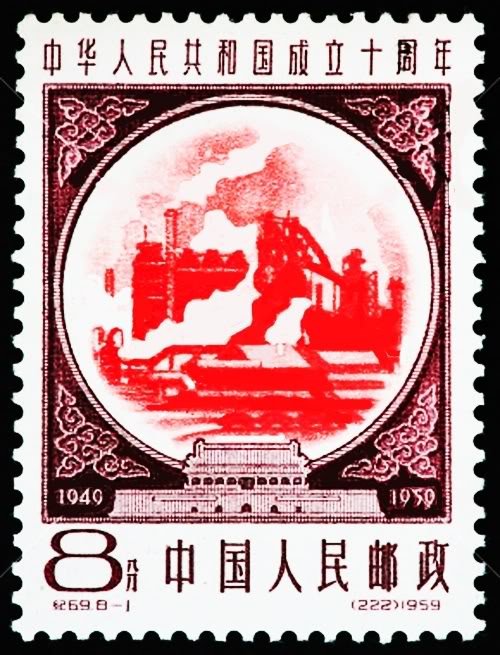 PORTFOLIO POINT: A fall in China’s demand for iron ore, combined with a boost in supply, will lead to lower prices and put the margins of Australia’s big producers under pressure.
PORTFOLIO POINT: A fall in China’s demand for iron ore, combined with a boost in supply, will lead to lower prices and put the margins of Australia’s big producers under pressure.Like a thief in the night, it crept across our news screens a two weeks ago: “The rate of China’s iron ore demand has peaked…”
This report from Dow Jones’ wire service follows recent comments by BHP that Chinese demand will be weaker than previously anticipated.
But Peter Richardson, Morgan Stanley’s global metals chief economist, is putting forward a strong investment case for the “crucial” steelmaking commodity. Remember; Never ask a barber whether you need a haircut.
For what it’s worth (and I know it’s not a widely accepted view right now), I think commodities are cyclical. When prices are low, there’s precious little investment in building productive capacity; the lack of investment and long production lead times result in supply lagging demand. As prices rise, investments are proposed, delayed and then made, and this pattern causes prices to extend their rise. Then just as prices peak, marginal operators come on line, backed by NPV calculations that assume the high prices will be sustained. It’s in their interest to be bullish about the future, because their jobs and reputations – as well as the dollars they have attracted as capital – are all on the line. But eventually, supply increases and prices stop going up; if it can’t go on forever, eventually it must stop.
And a commodity company has no competitive advantage, no compelling reason for people to pay more for their product or service. Their customers arrive at the counter with a price and say: ‘This is the best price we can get from someone else – can you beat it?’ The commodity business, which lacks any competitive advantage, has no option but to say ‘yes’, otherwise it runs the risk of underutilising its production capacity and its machinery sits idle. This is the antithesis of the business with a true competitive advantage.
The most valuable differentiator or competitive advantage is one that allows the business to simply raise the price each year without losing any business at all, even if excess productive capacity exists. Clearly, I am not describing the iron ore business.
In 2010, global mine iron ore production amounted to 2590mt. Of this, China produced 1070mt. By 2011, global mine production had grown to 2800mt, or a growth rate of 8.1%. Australia’s production from 2010 to 2011 grew by 11% to 480mt, and China’s production grew by 12.1%.
In 2010 China imported almost 60% of the world’s total iron ore exports and produced about 60% of the world’s pig iron. China’s significant participation is the main factor upon which sustainable expansion of the global iron ore industry depends. But China’s demand is slowing.
Peter Richardson (the barber for the purposes of this story) reckons even though the growth rate of iron ore demand from the world’s second-biggest economy has likely peaked, the sheer size of China’s requirements means the market will remain imbalanced until 2014 at least. Because of the very large numbers, he says a 3% or 4% year-on-year increase on China’s existing steel production base still requires close to 40 to 50mt more iron ore this year than last year.
The statistics that I have, however, suggest iron ore production globally could grow by 8% again. If China were to import another 60% of the world’s total iron ore exports, that would mean China imports an additional 136mt, but as Peter Richardson speculates, China will require 40-50mt. If China doesn’t buy the extra production, what does the additional production – that which isn’t imported by a slowing China, whose iron ore demand has peaked – do to prices? The pressure is, of course, for prices to come down.
Morgan Stanley and I agree on this. They are, of course, quite precise about just how prices will fall. Their latest forecast is that iron ore will trade at $US151 per metric ton, $US160 and $US140 in 2013 and 2014, respectively, and $US125 in 2015, $US110 in 2016 and $US105 in 2017. And if iron ore prices actually do that, I am the Tooth Fairy. Commodity prices don’t rise and fall so smoothly. They fall in fits of fear.
Either way, declining prices put pressure on margins unless capital expenditure is scaled back. Correction: even if capital expenditure is scaled back. And that’s what I think could be the outlook for some of Australia’s big iron ore producers.
Fig 1. Iron Ore Price chart
This is occurring at exactly the same time as analysts and brokers get very bullish about the large order wins and full pipelines for many mining services businesses. In the Montgomery [Private] Fund, we have owned mining services businesses for a year, but suddenly our once-comfortable train has become very crowded.
Fleetwood is one such business, providing manufactured accommodation to the resource industry, including BHP’s iron ore businesses. The company will also produce manufactured accommodation for caravan parks, as well as transportable homes. It is also the second-largest manufacturer of caravans in Australia.
And if you didin’t already know that I use Skaffold a lot here
Figure 2. Skaffold’s current Fleetwood Intrinsic Value Chart.
Source: www.Skaffold.com – be sure to register for next week’s webinar by clicking here
Fleetwood’s recent results met the market’s expectations at the earnings level. Indeed, the $26.9 million profit for the first half of the 2012 financial year was slightly better than some analysts’ expectations. The balance sheet was also very strong, with net cash of $13 million, and operating cash flows were equally strong, increasing by 210% to $47.6 million. But revenue was down; manufactured accommodation revenue fell by 7%. For recreational vehicles, revenue was down 12% and EBIT for this business fell 61%.
With timid and shy consumer sentiment putting pressure on Fleetwood’s recreational vehicles business, the company’s near-term future results will depend very much on resource companies.
Tellingly, the company’s half-year outlook statement revealed just how dependent on the resource sector many companies like Fleetwood have become: “demand for manufactured accommodation for the West Australian resources sector is expected to continue to strengthen as more projects are approved and moving to the construction stage.”
Analysts talk about current high levels of tender activity from resource projects that are likely to emanate over the coming 12 months. Mastermyne, for example, a company I wrote about here a couple of weeks ago, is seeking 900 people for which it has advertised in Poland to meet demand. But given my earlier comments about a slowing China and the impact that could have on iron ore prices, perhaps many of these companies and the analysts that follow them need to lower their expectations.
Many investors have seen planned projects shelved before and if any further declines in China’s demand for iron ore occur, the impact on the single cylinder of the Australian economy that is still running won’t have a happy impact on all those BHP and Rio shares that have been inherited by a generation of baby boomers nearing retirement.
Posted by Roger Montgomery, Value.able author, Skaffold Chairman and Fund Manager, 11 April 2012.
by Roger Montgomery Posted in Energy / Resources, Manufacturing.
-

MEDIA
Can Apple’s share price continue to climb?
Roger Montgomery
April 3, 2012
Roger Montgomery discusses with Ticky Fullerton on ABC1’s ‘The Business’ how the ever-increasing climb of Apple’s share price is likely to come under pressure. Watch here.
This edition of The Business was broadcast 4 April 2012.
by Roger Montgomery Posted in Consumer discretionary, Energy / Resources, Intrinsic Value, Investing Education, TV Appearances.
-

MEDIA
Is there gold in ‘them-there hills’ for investors in Red5
Roger Montgomery
April 1, 2012
Roger Montgomery discusses the prospects for Gold-Miner Red5 (RED) in this Money Magazine article published in April 2012. Read here.
by Roger Montgomery Posted in Energy / Resources, Investing Education, On the Internet, Value.able.
-
Who’s really doing the coal mining?
Roger Montgomery
March 30, 2012
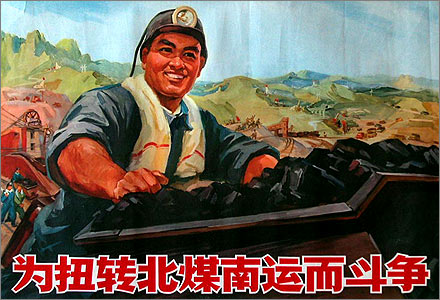 PORTFOLIO POINT: Delta SBD is weaker than its peer Mastermyne in many respects, but with an expansion in Queensland on the cards, things “might” change.
PORTFOLIO POINT: Delta SBD is weaker than its peer Mastermyne in many respects, but with an expansion in Queensland on the cards, things “might” change.Spec.u.li.tis (noun) 1. Inflation of one’s speculative stock-picking abilities.
In my line of work, I meet many finance industry professionals who generously forward their speculative tips unsolicited. A couple of them – the professionals, not the tips – are very good and have regularly mentioned stocks that have risen substantially. They tell me that some of these stocks will continue to rise substantially and because their track record is reasonably good – I believe one has funded an exotic car habit through speculation – and their research more in-depth than I would ever consider conducting on such speculative ventures, given the small amount of money involved for me, I occasionally weaken and succumb to their ‘trust me’ pleadings. Rarely does this end well for me, hence the small amounts of money involved and very infrequent ventures. I never expect to make anything from their high-risk speculative tips and I don’t view their current crop (NSE, COE, SEA, VMG and BTR, if you must know) any differently.
I do expect to do well building and maintaining a portfolio of extraordinary businesses bought at discounts to intrinsic value and that’s the philosophy I describe in detailed steps in Value.able, which you can only purchase online here.
I cannot value a company that currently makes no money, so my own brand of speculation (if that is what it should be called) would still need a business. That business needs to be generating a profit too and it needs to produce a reasonable return on equity, while trading at a discount to intrinsic value. This is as speculative as it gets for me (and it doesn’t sound much like speculation at all).
On a hiding to nothing, a refresher on intrinsic value is appropriate.
I use a proprietary model for calculating intrinsic value which you can learn by reading Value.able. In essence, if I have a bank account with $10 million and that bank account earns an interest rate return of 20%, and I decided to auction off the bank account in the public market, I am reasonably certain I would be able to secure more for that account than the $10 million of equity in it. Further, if I have two such accounts and one account pays all the interest out each year and the other pays no interest out but retains it, and each continues to earn 20% per annum, the account that paid no interest out would be worth more. Provided I cannot achieve a 20% return elsewhere, the latter account’s ability to compound earnings at 20% ensures its higher value.
But imagine a bank account that had $10 million of equity and was earning, say 12%, retaining and compounding 65% of that return, and was available for $9 million. That’s right, a discount to equity. I think I have found just such a company. It’s not perfect, as there is debt and arguably unjustified goodwill on the balance sheet involved. It’s both too small (about $100,000 worth of trades per month on average) and too risky for The Montgomery [Private] Fund, but it ticks a few boxes to warrant some speculative exposure for members of the Montgomery team, given its price.
Delta SBD (ASX: DSB) is a mining contractor and a peer to Mastermyne (MYE) – a company whose shares we do own, in very small quantity, through The Montgomery [Private] Fund and which I wrote about last week and which you can read about by clicking here.
Figure.1 Skaffold Line screenshot of Mastermyne’s (ASX: MYE) share price and intrinsic value.
(Skaffold displays intrinsic value charts like Figure.1 for every ASX listed company and they are automatically updated for the latest information announced by companies every single day. To access Skaffold for 30 days click here)
Analysts have recently become very excited about the coal sector if not the entire mining services sector because it is enjoying healthy tender activity, contract wins and filling, if not full, order pipelines. Attention has turned to coal, not because there is any shortage of supply but because the nuclear disaster in Japan last year (which was indeed a tragedy for Japan and her extended family) caused many countries to rethink their nuclear power generation strategies. Cheap and with infrastructure in place, coal is once again a preferred if not desired source of energy. Australia also enjoys a reputation for relatively clean coal (note ‘relative’)
Coal 101:
There are two types of coal; Metallurgical or Coking Coal and Thermal coal. Thermal is used often to heat water to produce steam that turns turbines for power generation. Metallurgical or Coking coal is used in steel production. The impact on the price of both will be determined by demand from Japan, China and India.
“Two forms of coal are mined in Australia, depending on the region: high-quality black coal and lower-quality brown coal. Black coal is found in Queensland and New South Wales, and is used for both domestic power generation and for export overseas. It is generally mined underground before being transported by rail to power stations, or export shipping terminals. Black coal was also once exported to other Australian states for power generation and industrial boilers.Brown coal is found in Victoria and South Australia, and is of lower quality due a higher ash and water content. As a result Victoria adopted German power station and briquette technology in the 1920s to utilise the brown coal reserves of the Latrobe Valley. Today there are three open cut brown coal mines in Victoria used for baseload power generation.Australia is the largest exporter of coal in the world, with most of that going to Japan. Total production of raw black coal in Australia in financial year 2010-11 was 405 million tonnes (Mt.), down from 471 Mt. in 2009-10. This drop was largely as a result of the Queensland floods of January 2011 where production fell by some 30%.
According to the Australian Energy the reserves to production ratios for black and brown coal in Australia are 111 years and 539 years respectively, however these figures do not account for growth in production. Growth of Black coal exports in Australia has been growing at a rate of 5% (on average of the last 20 years). If this rate of growth was maintained to extinction all black coal in the country would be depleted in around 25 years, with the peak in production occurring in 2014.
Australia is the world’s largest exporter of coking coal – accounting for over one-half of global export supply, and the second largest exporter of thermal coal (see Table below). Some other countries are larger producers of these commodities than Australia, but they typically consume the bulk of their domestic production and hence have a less significant role in the global resource export market. This is particularly noteworthy for China, which is the largest producer of coking and thermal coal but also the largest global consumer of these commodities. Similarly, the United States and India are the second and third largest producers of thermal coal, but are significant consumers of their own coal as well.
Table 1. Global Market for Coal. Source: RBA Bulletin 2011
Coal mining in Australia is the subject of strident criticism from the environmental movement, because burning coal releases carbon dioxide, which is generally understood to contribute to climate change, global warming, sea level rise and the effects of global warming on Australia. Coal burning produces 42.1% of Australia’s greenhouse gas emissions, not counting export coal. As a result, coal is a politically charged subject and the proposed Carbon Pollution Reduction Scheme which followed the draft report of the Garnaut Climate Change Review has put a price on carbon. This would be likely to impact most heavily on brown coal usage within Australia (particularly in the Latrobe Valley in Victoria) for power generation.
Why the heightened activity in coal?
This 20 year price chart of Thermal Coal may help answer the question…
The chart for coking coal looks similar. In the near term however, US domestic demand is falling due to competition from shale gas for power generation and lower coking coal demand from steel mills. Consequently, central and inland US coal mines are seeing sales and prices weaken. Europe is looking even worse. South African cargoes, much of them destined for Europe, fell to $100 per ton in late 2011 from up to $120 per ton earlier last year.
China, on the other hand, has remained a robust importer of thermal and coking coal. Imports reached 13.3 million tons in August 2011 from 6.1 million tons in March that year.
HSBC expects India to be the fastest-growing importer of thermal coal with imports rising 32 percent to 79 million tons in 2011 and 19 percent or 94 million tons expected in 2012 despite rising domestic production.
In 2011 China has cut coking coal imports from Australia, due to the flooding in Queensland, and then because Mongolia – China’s large source – has lower delivery costs than Australia.
Weak demand in the rest of the world and stable yet slowing growth in China will put a cap on further price rises.
DSB’s mining contracting segment specialises in the provision of services for the underground coal mine industry, whole of mine operations, roadway development, longwall relocations and support, conveyor installations and maintenance, plant hire and maintenance, supplementary labour, and mine service. The latter includes secondary support installation, excavation, ventilation device installation and services/utility installation/recovery. In other words DSB provides labour and equipment for large blue chip coal miners. Its clients include BHP, Boral and Xstrata, some of whom have been clients for over a decade.
The company’s description sounds a lot like Mastermyne and the regions it operates in are also the same- providing mining services in the Illawarra, Hunter Valley and the Western regions of NSW (Gunnedah), and the Bowen Basin in Queensland.
These similarities do highlight an important risk – the relatively low barriers to replication and competition, which in turn are reflected in DSB’s lower returns on equity. Further, like Mastermyne, limited ‘through-the-cycle’ performance transparency means investors are right to be cautious about a company that is either new or newly-listed. Delta DSB floated was formed after the merger of two companies in 2007 and while services have been provided for 16 years, the company floated in Dec 2010 after raising $2.85 million, $750,000 of which paid for float costs, $570,000 went into the company’s bank account and $1.53 million was used to repay shareholder loans (went into incumbent’s pockets).
The founder and CEO Steve Bizzaca, own 33% of the business and collectively directors own 67.7% of the stock making the usual illiquidity of a small company even more accute.
Some of the differences between Matsermyne and Delta SBD are found in their price and operations. Mastermyne has almost three quarters of its contracts by number based in Queensland. It enjoys higher margins there. Delta SBD, on the other hand, has three-quarters of its contracts based in New South Wales. DSB is also more capital and labour-intensive than Mastermyne, reflecting its current capital expenditure programme. And the capital expenditure program has also caused divergent balance sheets. Mastermyne’s debt is falling and it generates positive free cash, while DSB has more debt and (currently) negative free cash flow.
You can see why Mastermyne is a small position in the Montgomery [Private] Fund and DSB is not. But as the company expands in Queensland, some of these price-limiting issues may abate. And that’s where any value could, with the low liquidity, quickly disappear just as the valuation starts rising.
For the first half of 2012, DSB reported revenue up 40% and a normalised net profit of $3.5 million, up 61.0% on the first half of 2011. Importantly, EBITDA margins improved compared to the previous corresponding period and the company announced a 1.5 cent dividend.
Figure.2 Skaffold screenshot, Delta SBD (ASX:DSB), Dividend Per Share including forecasts.
Like Mastermyne written about earlier, you have to watch cash flow, because capital expenditure increases in anticipation of equipment demand for new contract wins, but the ramp-up in the number of staff, from 418 to 489, indicates optimism on this front. DSB’s forward order book confirms work in hand for the second half of FY12 is $60M. $93M has is locked in for FY13 and $69M for FY14. DSB says it has also been “short listed” for a further $70M in new contracts, is negotiating about $7M and is tendering for an extra $333M.
While inexperienced and amateur investors may get excited by all this ‘activity’ and especially when a little company has big ‘blue-chip’ clients, experience has shown us time and time again that tender pipelines can dry,up or even mysteriously disappear when prices or economics are no longer attractive. This is best highlighted by a recent note in the Sydney Morning Herald:
Sydney Morning Herald – 5th Mar 2012 – Paddy Manning
“HUNTER VALLEY miner Gloucester Coal is struggling to shift stockpiles worth almost $40 million as demand for its semi-hard coking coal softens.
Gloucester, which will this week release details of its proposed $8 billion merger with Chinese-owned firm Yancoal, disclosed in its half-year earnings presentation that stockpiles at its Gloucester Basin operations remained high at the end of last year due to difficulty in shifting its coking product.
“In response to this sharp decline in demand for metallurgical coals, management took steps to change its production profile towards producing a higher percentage of thermal coal,” Gloucester said.
Gloucester would not comment on Friday but it is understood the soft demand is due to global economic uncertainty having an impact on Asian steel mills, which are themselves stockpiling coking coal.
A representative with coal industry analysts IHS McCloskey, Bruce Jacques, said Gloucester’s situation could be “atypical, because the type of coal they produce is sometimes not as easy to sell.”
Mr Jacques said transport bottlenecks could also be responsible at the “pretty congested” Newcastle port.
“There’s the best part of 40 vessels waiting off the terminal,” he said. “Companies are sitting on some allocation through Newcastle that they’re not going to be able to use.”
“It’s no secret that demand is easing. In fact, demand for both thermal and coking coal is easing. The coking coal price has been falling for three quarters and it’s likely to fall for the next quarter as well.”
It therefore makes sense to be conservative rather than optimistic in your estimates of value for DSB and remember high operating leverage and exposure to commodities means profits can quickly turn to sharp losses in this industry.
For now DSB enjoys a strong tender pipeline and the momentum from a generally rising tide in coal production. At the current price of 80 cents (APril 1 Price update: $0.99), the shares are trading at just seven times earnings and more importantly, at a discount to forecast 2012 equity, even though that equity generates a positive return of circa 12 per cent.
So there you have it – the first and last time you will hear about speculation from me.
This column was first published on March 21, 2012. Not a recommendation. Be sure to seek and take personal professional advice. Be sure to read the warnings.
P.S. The featured Chinese 1972 poster reveals China has been trying to solve the problem of coal transportation for more than 35 years. The inscription along the bottom reads, “Strive to eliminate the need to transport coal from North to South.”
Posted by Roger Montgomery, Value.able author, Skaffold Chairman and Fund Manager, 31 March 2012.
If you enjoyed this post and would like to see more, and you are on Facebook be sure to click ‘like’ below. Thank you in advance for feeding the flame of value investing.
by Roger Montgomery Posted in Energy / Resources, Skaffold.
- 4 Comments
- save this article
- POSTED IN Energy / Resources, Skaffold
-
Guest Post: What’s the real BHP share price?
Roger Montgomery
March 29, 2012
 Portfolio Point: BHP Billiton is well known to every Australian investor, but what you may not be aware of is the unique opportunity the corporate structure offers the trader and investor.
Portfolio Point: BHP Billiton is well known to every Australian investor, but what you may not be aware of is the unique opportunity the corporate structure offers the trader and investor. BHP Billiton was formed when BHP and Billiton merged in June 2001; following the merger the companies maintained their separate stock exchange listings. Australian investor know BHP Billiton Limited (ASX:BHP) traded on the Australian Stock Exchange, the other major listing is on the London Stock Exchange (LSE:BLT) BHP Billiton Plc. A share bought on either exchange has equal economic and voting rights, meaning you receive the same dividend payment and have equal claim to the company’s assets.
A logical person would assume that adjusted for the exchange rate a share of BHP Billiton Limited would trade very closely to BHP Billiton Plc, surprisingly this assumption is not correct. BHP Billiton Plc has traded at a discount every day for the last five years compared to the Australian listed BHP. If the shares were interchangeable between the exchanges the law of one price would remove the price difference, but in this case it is not possible to transfer a London listed BHP share to the Australian Stock Exchange, so there is not an arbitrage trade opportunity.
On the other hand, as the discount does not remain constant under all market conditions there is an opportunity to profit in the movement of the spread. To trade the spread a person buys one BHP and sells the other listed BHP, the trader is in a hedged position and is not concerned by the price movement of BHP they are just concerned by the movement of the discount/premium between the two shares.
As the shares are traded on different stock exchanges in different currencies, the exchange rate and the movement of the exchange rate needs to be considered if a trader is going to take a spread position. Fortunately in this case both are also traded on the New York Stock Exchange (NYSE) in US dollars through the use of American Deposit Receipts (ADR) an ADR traded on the NYSE represents shares in a foreign company. The ADR shares are interchangeable with the company it represents, so the law of one price keeps the price of the ADR adjusted for the exchange rate in line with the share it represents.
During the last five years the London listed BHP ADR (NYSE:BBL) has traded between 78% and 96% of the price of an Australian listed BHP ADR (NYSE:BHP), with an average of 86%.An excellent risk/return ratio is obtained if the trader can buy the spread near it historic low and sell when the spread moves up to its average and the timing to perform this trade is when the price of BHP is collapsing. In November 2008 when ASX:BHP hit the low of $20.10 the above spread moved 8% in 9 days, 8% might not sound like a great return but as the trade is a hedged position leverage is safely utilised to increase the return on invested capital.
On the other hand, if you are an Australian value investor who wants to buy BHP shares at a discount to their intrinsic value there is a greater margin of safety in buying the London listed BHP for a 15% discount compared to buying the Australian listed BHP. If you follow Roger’s advice and only invest in the highly rated companies on Skaffold then BHP is not going to be a buy for you today at any price, but as the financial situation of every company is constantly changing one day in the future BHP may be rated A1 on Skaffold and at that time it might be worth you considering the London listed BHP.
Author: David Smith 13 March 2012
by Roger Montgomery Posted in Companies, Energy / Resources, Insightful Insights.
